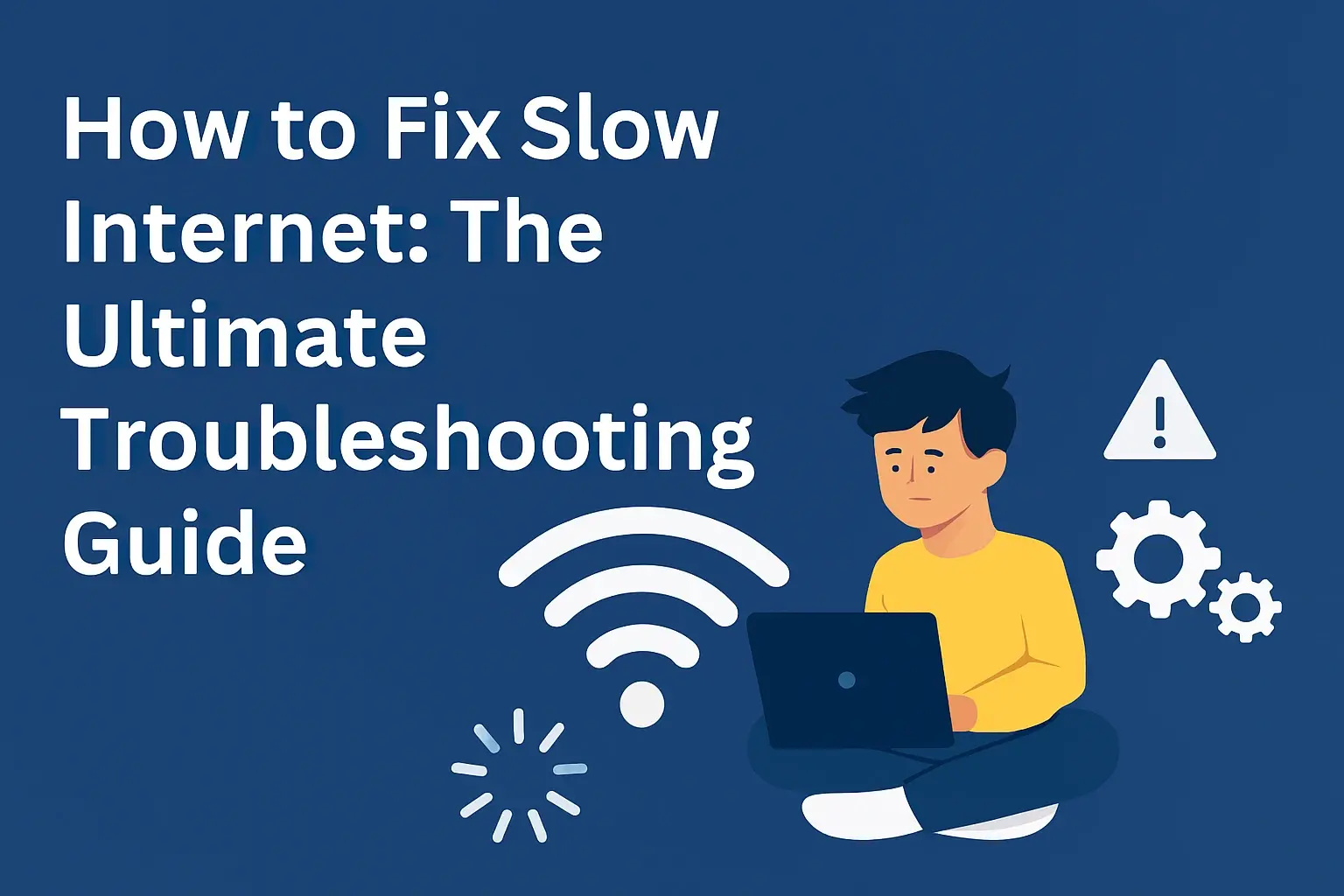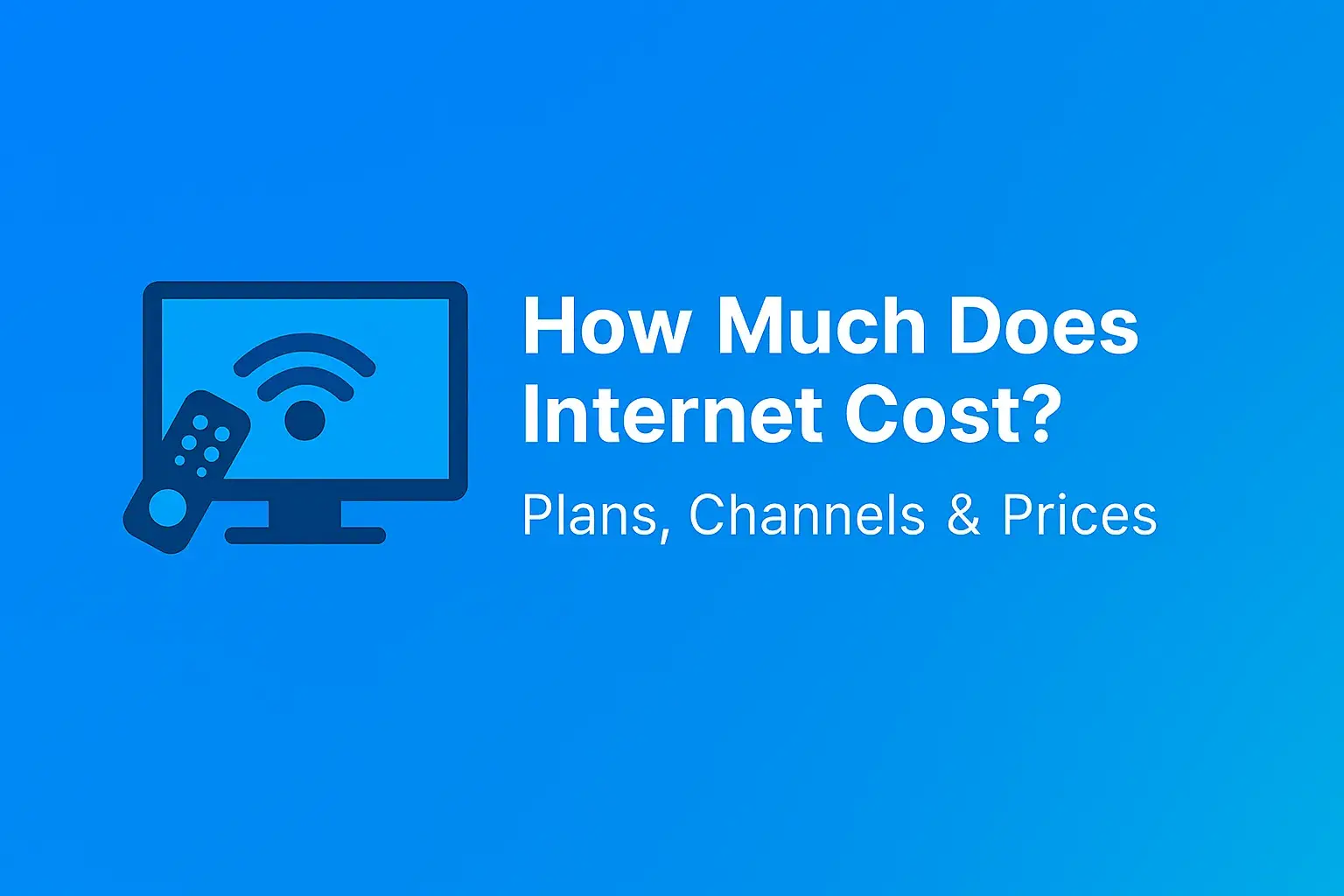What is a Good Internet Speed? Everything You Need to Know

Discover what constitutes a good internet speed in 2025. This comprehensive guide breaks down download/upload speeds, latency, and bandwidth, correlating them with common online activities like streaming, gaming, and remote work. Learn how to assess your needs, understand provider jargon, and optimize your connection for a seamless digital experience.
What is a Good Internet Speed in 2025? A Comprehensive Overview
In the ever-evolving digital landscape of 2025, the question of "what is a good internet speed?" is more pertinent than ever. As our reliance on stable, high-speed internet grows for everything from remote work and online education to immersive entertainment and smart home management, understanding your connection's capabilities is crucial. A "good" internet speed isn't a one-size-fits-all metric; it's a dynamic measure that depends heavily on your individual usage patterns, the number of devices connected, and the types of online activities you engage in. Gone are the days when dial-up was sufficient for basic email. Today, we're talking about speeds that enable seamless 4K streaming, lag-free online gaming, and instantaneous video conferencing. According to recent industry reports from sources like Statista and Ookla's Speedtest Global Index, the average fixed broadband download speed globally is projected to exceed 150 Mbps by mid-2025, with upload speeds also seeing significant increases. However, averages can be misleading. What might be considered "good" in a rural area with limited options could be considered subpar in a densely populated urban center with access to fiber optic networks. This article aims to demystify internet speeds, providing you with the knowledge to assess your current connection, understand what providers are offering, and ultimately determine what constitutes a "good" internet speed for your specific needs in 2025.
The digital world is no longer a luxury; it's a necessity. From managing finances and staying connected with loved ones to accessing critical information and engaging in professional development, a reliable internet connection underpins modern life. Therefore, ensuring you have adequate speed is not just about convenience; it's about participation. As we delve deeper into the year, the demand for bandwidth continues to surge, driven by the proliferation of high-definition content, the rise of the metaverse, and the increasing adoption of bandwidth-intensive applications. This guide will equip you with the insights needed to navigate the complexities of internet speeds, ensuring your online experience is smooth, efficient, and enjoyable.
Understanding the Core Concepts: Speed, Bandwidth, and Latency
Before we can determine what a "good" speed is, it's essential to understand the fundamental components that make up your internet connection. These are often used interchangeably, but they represent distinct aspects of your online experience.
Download Speed
Download speed refers to the rate at which data is transferred from the internet to your device. This is the most commonly advertised metric by Internet Service Providers (ISPs). It's measured in megabits per second (Mbps) or gigabits per second (Gbps). Higher download speeds mean faster loading of web pages, quicker downloads of files, and smoother streaming of video content. For example, downloading a large file like a movie or a software update will be significantly faster with higher download speeds.
Upload Speed
Upload speed, conversely, is the rate at which data is transferred from your device to the internet. This is crucial for activities like sending large email attachments, uploading photos and videos to social media or cloud storage, participating in video calls, and playing online multiplayer games where your actions need to be transmitted to the server. Historically, upload speeds have been significantly lower than download speeds in most residential plans, but this is changing as demand for content creation and real-time communication increases. Many modern applications and services now rely heavily on robust upload capabilities.
Bandwidth
Bandwidth is often confused with speed, but it's more accurately described as the maximum capacity of your internet connection. Think of it like a highway: speed is how fast cars can travel on the highway, while bandwidth is how many lanes the highway has. A wider highway (higher bandwidth) can accommodate more cars (data) simultaneously without causing traffic jams. So, while you might have a high speed, if your bandwidth is low, multiple devices or demanding applications running at the same time can slow down your overall experience. ISPs typically advertise plans based on their maximum bandwidth. For instance, a "100 Mbps plan" means your connection has a maximum capacity of 100 Mbps.
Latency (Ping)
Latency, often referred to as "ping," measures the time it takes for a small packet of data to travel from your device to a server and back. It's measured in milliseconds (ms). Lower latency is better, as it indicates a more responsive connection. High latency can cause noticeable delays in online activities, especially in real-time applications. For example, in online gaming, high latency can lead to "lag," where your actions appear on screen with a delay, making it difficult to play competitively. Similarly, during video calls, high latency can result in choppy audio and video, and awkward delays in conversation. While download and upload speeds are about the volume of data transferred, latency is about the responsiveness and immediacy of your connection.
Jitter
Jitter is the variation in latency over time. If your latency is inconsistent, you experience jitter. This can be particularly disruptive for voice and video communication, leading to dropped calls, distorted audio, and frozen video feeds. Low jitter is essential for real-time applications where consistent data flow is critical.
Current Trends and Benchmarks for Internet Speed in 2025
The internet speed landscape in 2025 is characterized by rapid advancements and increasing user expectations. Several key trends are shaping what is considered "good" and what is achievable.
The Rise of Fiber Optics
Fiber optic internet, which uses light signals transmitted through glass strands, continues its expansion and is now the benchmark for high-speed internet. Fiber offers symmetrical speeds (download and upload speeds are the same) and significantly lower latency compared to older technologies like DSL or cable. Many metropolitan areas and increasingly suburban regions now have access to fiber plans offering speeds of 1 Gbps (1000 Mbps) or even higher. For users with demanding needs, 1 Gbps is becoming the new standard for "excellent".
5G Home Internet
Wireless 5G technology is not just for mobile devices; it's also emerging as a viable home internet solution in many areas. While performance can vary based on network congestion and signal strength, 5G home internet can offer speeds competitive with cable and even some fiber plans, often with more flexible installation. Download speeds can range from 100 Mbps to over 1 Gbps in optimal conditions, with latency improving significantly over previous cellular generations. It's a strong contender for users in areas underserved by traditional broadband.
Increased Demand for Upload Speeds
The shift towards remote work, the explosion of video content creation (like TikTok, YouTube, and Twitch), and the growing adoption of cloud-based productivity suites have dramatically increased the importance of upload speeds. Many ISPs are now offering plans with higher symmetrical upload speeds, or at least significantly improved upload capacities on their cable and fiber offerings. A good plan in 2025 should ideally offer at least 20-50 Mbps of upload speed for moderate users, and 100 Mbps or more for heavy content creators or those with frequent large file uploads.
Global Speed Averages (2025 Projections)
Based on projections and current data from sources like Ookla, the global average fixed broadband download speed is anticipated to be around 150-175 Mbps in 2025. Average upload speeds are projected to be around 60-75 Mbps. However, these averages mask significant regional disparities. Developed nations with advanced infrastructure often see averages well over 200 Mbps download, while developing regions may still be in the double digits. Mobile broadband speeds are also increasing, with 5G networks pushing averages higher, potentially exceeding 100 Mbps in many areas.
Latency Benchmarks for Activities
For a smooth online experience in 2025, consider these latency benchmarks:
- Excellent (Under 20ms): Ideal for competitive online gaming, high-quality video conferencing, and real-time applications.
- Good (20-50ms): Suitable for most online gaming, HD streaming, and general web browsing.
- Acceptable (50-100ms): May experience minor lag in fast-paced games or slight delays in video calls. Acceptable for most streaming and browsing.
- Poor (Over 100ms): Noticeable lag in gaming, potential issues with streaming quality, and significant delays in video conferencing.
How to Determine Your Ideal Internet Speed: A Step-by-Step Guide
Determining the right internet speed for your household involves assessing your current habits and anticipating future needs. Here’s a structured approach:
Step 1: Assess Your Household's Internet Usage
Make a list of all the activities your household engages in online. Be specific. For each activity, consider how many people will be doing it simultaneously and how often.
- Web Browsing & Email: Generally requires minimal bandwidth (1-5 Mbps per user).
- Social Media: Moderate bandwidth, especially with video content (5-15 Mbps per user).
- Standard Definition (SD) Streaming: Requires around 3-5 Mbps per stream.
- High Definition (HD) Streaming (1080p): Needs approximately 5-10 Mbps per stream.
- 4K Ultra HD Streaming: Demands 25-50 Mbps per stream.
- Online Gaming: While download/upload speeds are important for game updates, latency is critical for gameplay. A stable connection with low latency (<50ms) is key. Bandwidth needs vary but 10-25 Mbps is usually sufficient for active play.
- Video Conferencing (e.g., Zoom, Teams): HD video calls typically require 5-10 Mbps download and 2-5 Mbps upload per participant. For multiple simultaneous calls, these needs multiply.
- Downloading Large Files (Software, Movies): Higher download speeds significantly reduce wait times. A 10 GB file at 100 Mbps takes about 13 minutes, while at 1 Gbps it takes just over a minute.
- Uploading Large Files (Videos, Backups): Crucial for content creators or those using cloud backups. Requires sufficient upload speed. A 1 GB file upload at 50 Mbps takes about 2.5 minutes.
- Smart Home Devices: While individual devices use little bandwidth, a large number of connected devices (smart lights, thermostats, cameras, speakers) can collectively add to the network load.
Step 2: Count Your Devices
Tally up all the devices that will likely be connected to your network simultaneously. This includes smartphones, tablets, laptops, desktop computers, smart TVs, gaming consoles, streaming devices (Roku, Apple TV), smart speakers, and any other internet-connected gadgets.
Step 3: Calculate Your Minimum Required Speed
Add up the bandwidth requirements for the most demanding activities that will occur concurrently. For example, if one person is streaming 4K video (50 Mbps), another is on an HD video call (10 Mbps download, 5 Mbps upload), and two others are browsing social media (15 Mbps each), your estimated simultaneous need would be around 80 Mbps download and 5 Mbps upload. It's wise to add a buffer of 20-30% to account for network overhead and unexpected usage spikes.
Step 4: Consider Latency Needs
If online gaming or real-time communication is a priority, focus on plans with low latency (under 50ms, ideally under 20ms). Fiber optic and some cable plans generally offer the best latency. DSL and satellite internet often have higher latency.
Step 5: Factor in Future Needs
Internet usage tends to increase over time. Consider what new devices or services you might adopt in the next few years. It's often more cost-effective to get a slightly higher speed tier now than to upgrade later.
Step 6: Review Your Current Speed Test Results
Use a reliable speed test tool (like Speedtest.net by Ookla or Fast.com) to measure your current internet speed. Perform tests at different times of the day, especially during peak usage hours, and on various devices. Compare these results to your calculated needs. If your current speed is consistently falling short, it's time to consider an upgrade.
Comparing Internet Speed Tiers: What Do They Mean for You?
Internet Service Providers (ISPs) typically offer various speed tiers. Understanding what these tiers mean in practical terms is crucial for making an informed decision. Here's a general breakdown of common speed tiers and their suitability for different user profiles in 2025:
| Speed Tier (Download Mbps) | Typical Upload Speed (Mbps) | Ideal User Profile | Common Activities Supported |
|---|---|---|---|
| 1-25 Mbps | 1-5 Mbps | Single User, Basic Needs | Basic web browsing, email, SD streaming for one device, occasional social media. May struggle with multiple users or HD content. |
| 25-75 Mbps | 5-15 Mbps | Small Household, Moderate Use | HD streaming for 1-2 devices, multiple users browsing, social media, online gaming (with good latency), basic video calls. |
| 75-150 Mbps | 10-25 Mbps | Average Household, Multiple Users | Simultaneous HD streaming on multiple devices, smooth 4K streaming for 1-2 devices, online gaming, frequent video conferencing, moderate file downloads/uploads. |
| 150-300 Mbps | 20-50 Mbps | Larger Household, Heavy Internet Use | Multiple 4K streams, heavy online gaming, frequent large file downloads/uploads, robust video conferencing for multiple users, smart home integration. |
| 300-500 Mbps | 30-75 Mbps | Power Users, Content Creators | Seamless 4K streaming on all devices, demanding online gaming, rapid large file transfers, high-quality video production uploads, running multiple demanding applications simultaneously. |
| 500 Mbps - 1 Gbps+ | 50-100 Mbps+ (often symmetrical) | Enthusiasts, Businesses, Future-Proofing | Handles virtually any internet task with ease. Ideal for households with dozens of connected devices, professional content creation, virtual reality, and ensuring peak performance for years to come. Often fiber optic. |
It's important to note that advertised speeds are often "up to" speeds, meaning you might not always achieve the maximum during peak hours or due to network congestion. For this reason, it's often recommended to choose a speed tier slightly higher than your calculated minimum need.
Best Practices for Maximizing Your Internet Speed
Even with a fast internet plan, several factors can affect your actual speed. Implementing these best practices can help you get the most out of your connection:
- Optimize Your Wi-Fi Router Placement: Place your router in a central, elevated location, away from obstructions like thick walls, metal objects, and other electronics that can cause interference (e.g., microwaves, cordless phones). Avoid placing it in corners or enclosed spaces.
- Use a Modern Router: Ensure your router supports the latest Wi-Fi standards, such as Wi-Fi 6 (802.11ax) or Wi-Fi 6E. These offer faster speeds, better performance in crowded environments, and improved efficiency for multiple devices. Consider upgrading if your router is more than 3-4 years old.
- Secure Your Network: Use a strong, unique password for your Wi-Fi network and enable WPA2 or WPA3 encryption. An unsecured network can be exploited by others, consuming your bandwidth and potentially compromising your security.
- Restart Your Modem and Router Regularly: Like any electronic device, modems and routers can benefit from a periodic reboot. This can clear temporary glitches and re-establish a fresh connection to your ISP's network. Aim to do this at least once a month.
- Update Router Firmware: Manufacturers regularly release firmware updates that can improve performance, security, and stability. Check your router's settings or the manufacturer's website for updates.
- Use Wired Connections When Possible: For devices that require the most stable and fastest connection (e.g., gaming consoles, desktop computers used for heavy tasks, smart TVs for 4K streaming), use an Ethernet cable directly connected to the router. Wired connections are generally faster and more reliable than Wi-Fi.
- Limit Background Bandwidth Usage: Be mindful of applications that consume bandwidth in the background, such as automatic software updates, cloud backups, or peer-to-peer file sharing. Configure these to run during off-peak hours or pause them when high-priority tasks are underway.
- Consider a Mesh Wi-Fi System: If you have a large home or areas with weak Wi-Fi signals, a mesh Wi-Fi system can provide more consistent coverage than a single router. These systems use multiple nodes to create a seamless Wi-Fi network throughout your home.
Advanced Strategies for Optimizing Your Connection
For users who demand the absolute best performance or are experiencing persistent issues, a few advanced strategies can further optimize their internet connection:
Quality of Service (QoS) Settings
Many modern routers offer Quality of Service (QoS) settings. QoS allows you to prioritize certain types of traffic or specific devices on your network. For example, you can configure QoS to give video conferencing or online gaming traffic higher priority than background downloads, ensuring a smoother experience for critical applications even when your network is busy.
DNS Server Optimization
The Domain Name System (DNS) server translates website names (like google.com) into IP addresses. Your ISP assigns a default DNS server, but using a third-party DNS service (like Google DNS or Cloudflare DNS) can sometimes offer faster response times, leading to quicker website loading. This is a minor improvement but can contribute to a snappier browsing experience.
Understanding Your ISP's Network
If you consistently experience speeds lower than advertised, especially during peak hours, it might be due to network congestion in your area. Research your ISP's network infrastructure and customer reviews regarding performance in your neighborhood. Sometimes, switching to a different ISP or technology (e.g., from cable to fiber) can yield significant improvements.
Network Monitoring Tools
For the technically inclined, using network monitoring tools can provide deep insights into your connection's performance. These tools can track bandwidth usage per device, identify bottlenecks, and analyze latency and jitter in real-time, helping to pinpoint specific issues.
Consider a Dedicated Router or Network Setup
For very demanding households or small businesses, a high-end consumer router or even a prosumer-grade router can offer more advanced features, better performance, and greater control over your network compared to basic ISP-provided equipment.
Common Internet Speed Myths Debunked
Several misconceptions surround internet speeds. Let's clear some of them up:
Myth: All Wi-Fi is the same.
Reality: Wi-Fi standards (like 802.11n, 802.11ac, Wi-Fi 6) offer vastly different speeds and efficiencies. Older standards are significantly slower and less capable of handling multiple devices compared to newer ones like Wi-Fi 6.
Myth: My advertised speed is what I always get.
Reality: Advertised speeds are "up to" maximums. Actual speeds can be affected by network congestion, router quality, Wi-Fi signal strength, the number of connected devices, and even the performance of the server you are connecting to.
Myth: More Mbps always means a better experience.
Reality: While higher speeds are generally better, latency and jitter are critical for real-time applications like gaming and video calls. A connection with lower latency but slightly lower download speeds might provide a better gaming experience than a high-speed connection with high latency.
Myth: My ISP is throttling my connection.
Reality: While some ISPs do engage in network management, outright throttling without reason is less common. More often, slow speeds during peak hours are due to general network congestion. However, some ISPs may throttle specific types of traffic (like P2P) or after you exceed data caps, if applicable.
Myth: A faster internet plan will fix all my online problems.
Reality: While speed is crucial, other factors like router performance, device capabilities, and even the website or service you're accessing can impact your experience. A slow website will still be slow even on a gigabit connection if the website's server is overloaded.
The Future of Internet Speeds
The trajectory of internet speeds is upward. By the end of the decade, we can expect even more significant advancements. Technologies like Wi-Fi 7 are already emerging, promising higher throughput and lower latency. Further expansion of fiber optic networks will make multi-gigabit speeds more accessible to residential users. The development of next-generation cellular technologies beyond 5G will also continue to push the boundaries of wireless connectivity, making fixed wireless access an even more competitive option. As bandwidth demands continue to grow with the increasing sophistication of online applications, virtual and augmented reality experiences, and the ever-expanding Internet of Things (IoT), ISPs will continue to invest in infrastructure to meet these needs. The concept of "good" internet speed will continue to evolve, with today's premium speeds becoming tomorrow's standard.
Conclusion
In 2025, defining a "good" internet speed is a nuanced endeavor, moving beyond simple Mbps figures to encompass a holistic understanding of download speeds, upload speeds, bandwidth, and latency. For most households, a speed tier offering between 100-300 Mbps download and 20-50 Mbps upload is increasingly becoming the sweet spot, capable of supporting simultaneous HD and 4K streaming, online gaming, remote work, and a connected smart home. However, individual needs vary significantly. Power users, content creators, and those with large households will benefit from higher speeds, ideally 500 Mbps to 1 Gbps or more, especially if fiber optic is available, offering superior symmetrical speeds and low latency. Conversely, single users with minimal online activity might find 25-75 Mbps sufficient, though future-proofing suggests aiming slightly higher. Crucially, always consider latency, especially for gaming and real-time communication, where speeds under 50ms are highly desirable. By carefully assessing your household's usage, counting connected devices, and understanding the capabilities of different speed tiers, you can make an informed decision. Remember to implement best practices like optimizing router placement and securing your network to ensure you're consistently achieving the best possible performance from your chosen plan. The digital world of 2025 demands a robust connection; understanding these factors empowers you to secure one that meets and exceeds your expectations.





